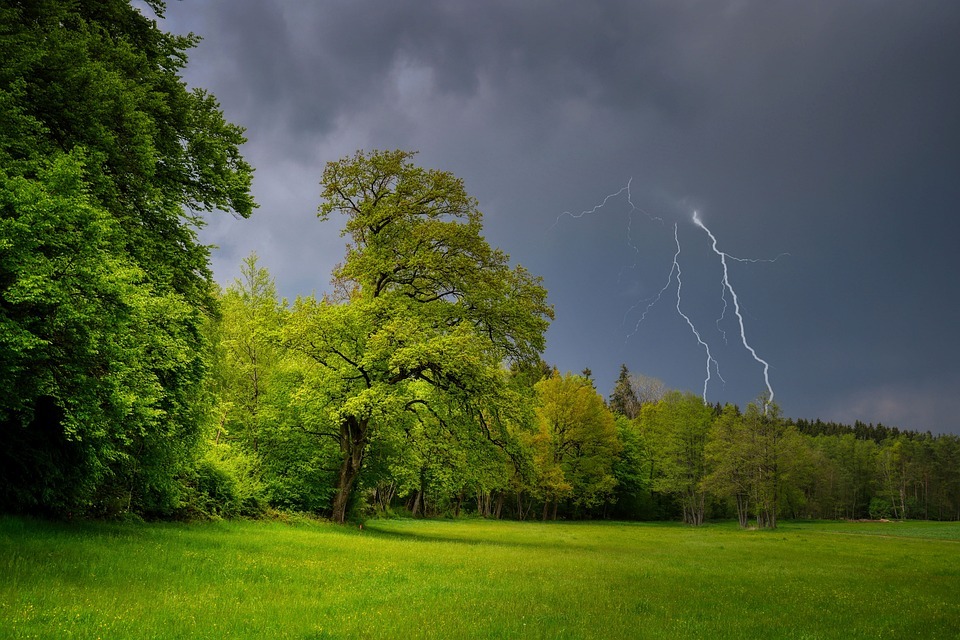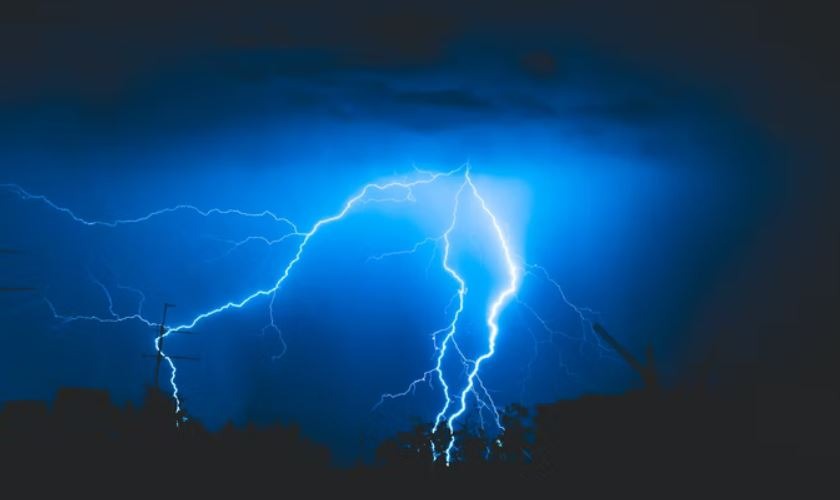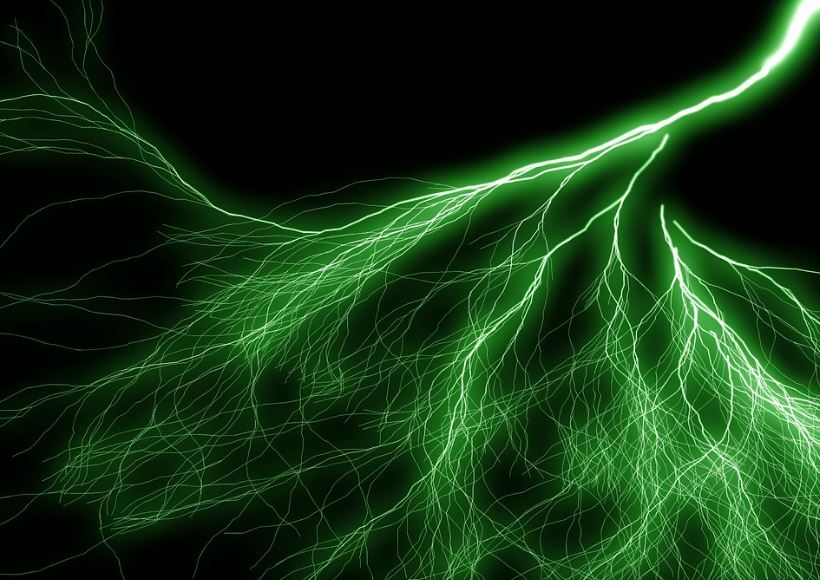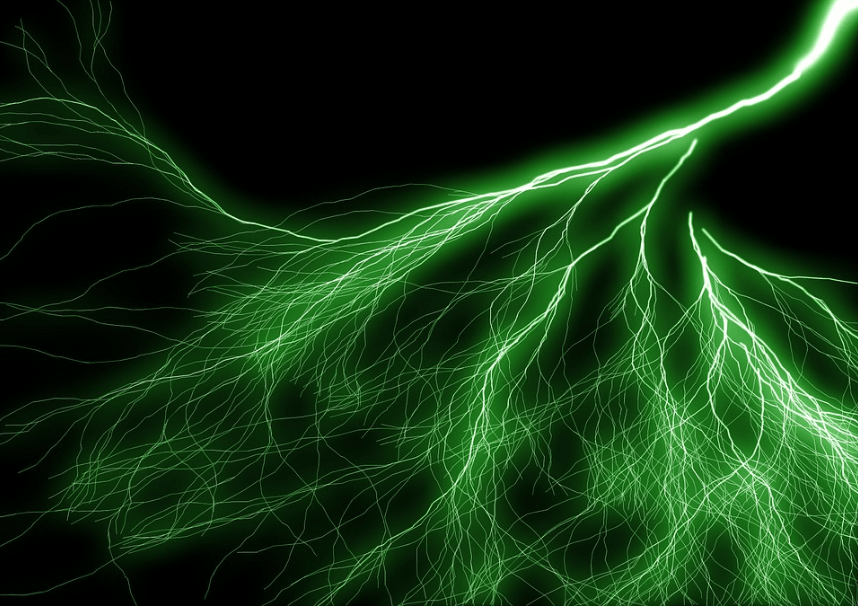Green Lightning and the Aurora Borealis: Are They Connected?
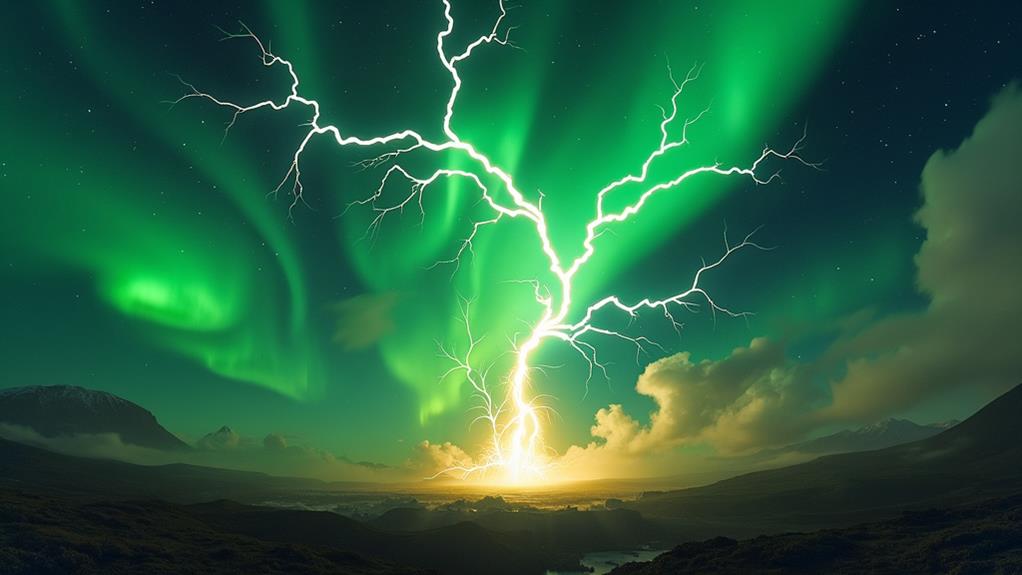
Have you ever wondered if there's a link between the rare phenomenon of green lightning and the mesmerizing aurora borealis? Both display striking green hues that captivate observers, yet they originate from distinct atmospheric processes. Green lightning typically occurs during thunderstorms, resulting from the ionization of air molecules. In contrast, the aurora borealis is caused by solar particles interacting with Earth's magnetic field and atmospheric gases. Despite these differences, the vivid green colors suggest a potential underlying connection. What insights might these natural wonders offer regarding the interplay between Earth's weather systems and solar activity? Let's explore these intriguing possibilities further.
Historical Perspectives on Auroras
Since the dawn of humanity, the aurora borealis has captivated those who witnessed its ethereal glow. Ancient civilizations, lacking scientific explanations, often turned to myths and legends to interpret this mystical phenomenon. The term "aurora borealis," coined by Galileo in 1619, reflects its cultural significance. He named it after Aurora, the Roman goddess of dawn, highlighting the light phenomenon's spellbinding allure.
Historical records show that the aurora borealis was documented by various civilizations. Ancient Greek poets referred to dawn as "Eos," invoking images of the sky's lively colors reminiscent of the aurora's displays. This demonstrates that humanity's fascination with the aurora borealis is not a recent development; it has been a source of wonder and reverence for millennia.
The blending of scientific knowledge with cultural narratives throughout history underscores the deep cultural significance of the aurora borealis. From Roman goddesses to poetic references, the aurora has served as a canvas for human imagination, demonstrating our enduring curiosity and awe for this natural phenomenon.
Scientific Explanation of Auroras
Auroras, including the captivating aurora borealis, occur due to interactions between charged particles from the Sun and Earth's magnetosphere. When the solar wind, a stream of charged particles, travels approximately 150 million kilometers to Earth, it can initiate auroral activity upon colliding with atmospheric gases.
As these charged particles encounter oxygen and nitrogen in the atmosphere, they excite these gases, causing them to emit light. Oxygen atoms primarily produce the green and red colors often seen in the aurora borealis. These stunning light displays are most visible near the poles, where Earth's magnetosphere directs the solar wind particles.
Auroral activity tends to intensify during geomagnetic storms, which occur when increased solar wind pressure disturbs Earth's magnetosphere. These disturbances can expand the auroral oval, making the aurora borealis visible at lower latitudes than usual.
Research into auroras is vital for enhancing our understanding of atmospheric dynamics and improving climate and weather modeling. It also offers insights into the effects of solar activity on Earth's environment, aiding in the preparation for and mitigation of geomagnetic storm impacts on technology and daily life.
Types and Colors of Auroras
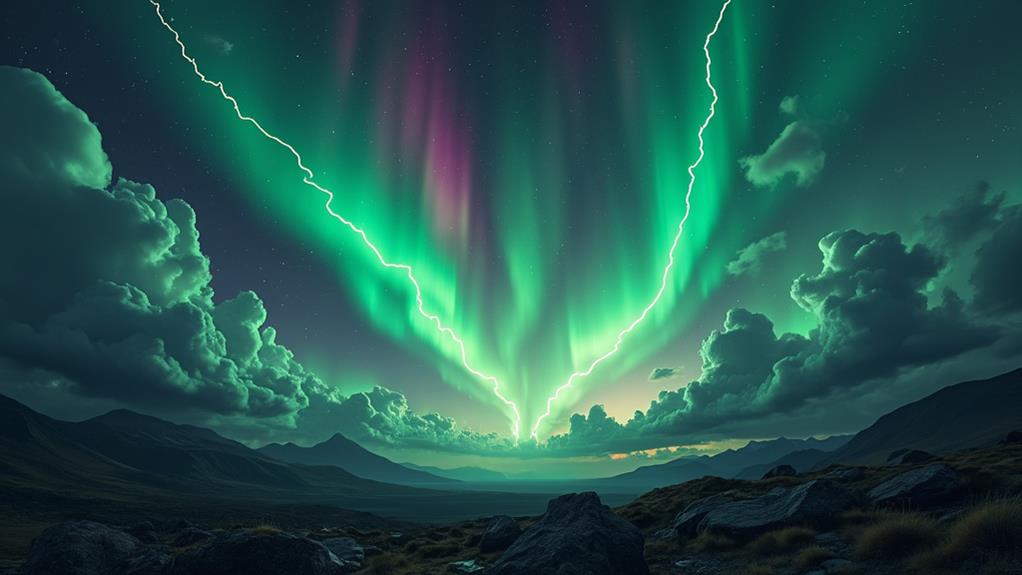
Exploring the types and colors of auroras offers a captivating visual experience. These natural phenomena can manifest as arcs, ribbons, bands, and curtains. The most common hue is green, resulting from excited oxygen atoms. Depending on atmospheric conditions, you may also witness red, purple, and lilac-pink tones, each contributing to the dynamic beauty of the aurora borealis.
Auroral Color Variations
When you gaze at the night sky and witness an aurora, you see a spectrum of hues created by different atmospheric interactions. Auroras occur when charged solar particles collide with atmospheric gases, producing a stunning display. The green color, the most common, comes from excited oxygen atoms emitting light at 557.7 nm. Meanwhile, a scarlet red glow appears at higher altitudes (around 630 nm) due to more energetic oxygen.
Your perception of auroral colors can vary based on atmospheric conditions. During twilight, green is the most visible color, standing out against the fading light. Nitrogen molecules also contribute to the auroral palette, adding purples, mauves, and lilac-pinks. Blue hues, though less common, occur at even higher altitudes due to unique atmospheric interactions.
Auroras are dynamic and can change rapidly, showcasing a range of color variations. Unique types like theta auroras and picket-fence auroras add to the mesmerizing visual spectacle, ensuring that no two auroras are exactly alike.
Dynamic Light Forms
The night sky can transform into a canvas of dynamic light forms, with auroras displaying a variety of shapes such as arcs, ribbons, and curtains. These auroral displays occur when solar particles collide with atmospheric gases, producing stunning visual effects. The most common color seen is green, caused by oxygen at lower altitudes. At higher altitudes, oxygen interactions produce red hues.
The spectacle extends beyond these colors. Nitrogen interactions at varying altitudes generate purple, blue, and pink hues, enriching the night sky with a vibrant palette. These dynamic patterns can change rapidly, making each moment unique and mesmerizing. Rare auroral types, like STEVE (Strong Thermal Emission Velocity Enhancement), add another layer of intrigue. STEVE appears as a narrow purple arc, providing unique insights into atmospheric phenomena.
The perception of these colors can vary based on background brightness and atmospheric conditions. For optimal visibility, seek auroras during twilight or on dark, clear nights. Each auroral display exemplifies the complex interplay between solar particles and atmospheric gases, creating nature's own light show right above you.
Optimal Viewing Conditions
Achieving the most memorable viewing experience of the Aurora Borealis hinges on understanding and optimizing several key conditions. Seek out clear skies and minimal urban light pollution, which are crucial for enhancing auroral visibility. To escape city lights, venture to remote areas, particularly in Norway, where the Northern Lights are best viewed from September to March. Prime viewing hours fall between 5 PM and 2 AM.
Equinoxes in late September and March are particularly favorable due to peak solar activity, resulting in brighter auroral displays. The Auroral Ovals near the Arctic Circle offer the highest chances for sightings, so consider traveling across this region for an awe-inspiring experience.
Weather conditions are critical; cloud cover can completely obstruct your view. Monitor local weather reports and aurora forecasts to plan your trip for clear, dark nights. By carefully selecting your viewing time and location, you can maximize your chances of witnessing the breathtaking beauty of the Aurora Borealis.
Community Engagement in Aurora Research
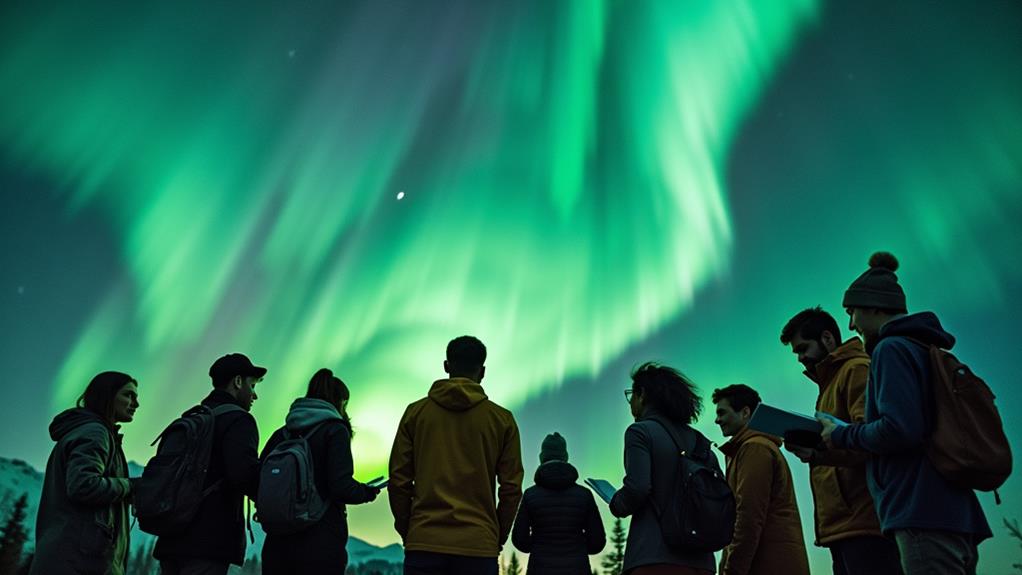
You can actively participate in aurora research through the Aurora Zoo project, which invites you to analyze data on auroras' energy and movement. By processing large datasets and reporting sightings, you're contributing to scientific understanding and connecting with a community that shares your passion. Subscribe to newsletters for updates and join others in exploring these mesmerizing natural phenomena.
Public Data Analysis Initiatives
Engaging the public in data analysis through initiatives like the Aurora Zoo project revolutionizes our understanding of auroras and their atmospheric impacts. By encouraging public participation, Aurora Zoo leverages the collective power of citizen science to analyze aurora data, focusing on the dynamics and energy release in the upper atmosphere. This collaboration enables participants to significantly contribute to processing large datasets, thereby enhancing our comprehension of atmospheric interactions during auroral events.
Your involvement in the Aurora Zoo project not only helps advance scientific knowledge but also introduces new perspectives that can influence meteorological practices. Community engagement fostered by this initiative creates a shared passion for understanding auroras and promotes awareness of their importance in atmospheric science.
Additionally, subscribing to the Aurora Zoo keeps you informed through newsletters featuring the latest aurora-related articles, exclusive content, and upcoming research initiatives. This continuous flow of information ensures your active participation in the scientific journey, bridging the gap between professional researchers and citizen scientists. Through your dedication and curiosity, you help uncover the mysteries of auroras, contributing to a deeper understanding of our planet's atmospheric phenomena.
Citizen Science Contributions
Citizen science contributions are crucial in advancing aurora research by leveraging the collective efforts of individuals passionate about atmospheric phenomena. As a citizen scientist, you can participate in projects like the Aurora Zoo, where your analysis of auroral data aids scientists in understanding energy release and movement in the upper atmosphere. Your aurora photography captures real-time geomagnetic activity, providing valuable insights into Auroral Ovals and solar activity.
Engaging in these activities not only enhances your knowledge of physics and astronomy but also helps researchers build extensive datasets. These datasets are essential for studying atmospheric interactions and could potentially influence future meteorological practices. Community engagement initiatives, such as newsletters and forums, keep you informed on the latest in aurora research and offer a platform to share your experiences and findings.
Shared Aurora Experiences
The magic of auroras captivates not only scientists but also communities of enthusiasts who eagerly share their experiences and insights. Your participation in aurora research through community engagement initiatives, such as the Aurora Zoo project, is invaluable. This citizen science effort empowers individuals like you to analyze auroral phenomena, focusing on their movement and shape in the upper atmosphere. By engaging in these activities, you directly contribute to understanding the energy release during the Northern Lights and their impact on atmospheric interactions.
Shared experiences within the aurora community foster collaboration and a deeper appreciation for these natural wonders. Discussing your observations with others creates a collective enthusiasm that fuels further exploration and discovery. Nature photography enthusiasts, in particular, benefit from these exchanges, gaining valuable tips and techniques for capturing future aurora events.
Auroras and Lightning Phenomena
During rare moments, the skies over polar regions and near the Baltic Sea can present an extraordinary spectacle: the simultaneous occurrence of auroras and lightning. These northern lights, caused by the interaction of solar wind with Earth's magnetic field, combine with the electric discharge of lightning to create stunning visual effects. The result is a breathtaking display where the ethereal greens and purples of the auroras dance alongside the electric bursts of lightning, illuminating the sky in a unique and mesmerizing way.
Auroras typically grace the polar regions, while lightning is more common during summer thunderstorms. However, when these atmospheric phenomena coincide, they showcase the dynamic interplay between different weather systems. The visual effects are further enhanced when reflected on water surfaces, creating an almost surreal scene that captivates anyone fortunate enough to witness it.
Photographers and nature enthusiasts seek out this rare combination, hoping to capture the transient beauty of these natural events. Observing auroras and lightning together not only highlights the Earth's magnetic field's interaction with solar wind but also exemplifies the sheer power and unpredictability of atmospheric phenomena. It's a reminder of the ever-changing and interconnected nature of our planet's weather systems.
Weather Conditions for Observing

Ideal weather conditions are crucial for observing the rare combination of auroras and lightning. Clear, dark skies are essential to witness the northern lights in their full splendor, as cloud cover can obstruct the view. Always check local forecasts to ensure optimal viewing conditions. The prime time to observe auroral displays is from September to March, particularly between 9 PM and 3 AM, in polar regions where these phenomena are most prevalent.
Remote locations, far from urban light pollution, offer the best chances of seeing the northern lights. High geomagnetic activity, often during solar storms, enhances the intensity of auroras, making them more visible and spectacular. Solar activity, especially during the solar maximum of the 11-year solar cycle, significantly improves the brightness and frequency of these displays.
Weather conditions are important; storms can both obstruct and amplify auroras due to increased geomagnetic activity. Planning your observation around these factors will maximize your chances of experiencing this breathtaking natural phenomenon. Therefore, always monitor weather and geomagnetic forecasts to ensure you don't miss this extraordinary spectacle.
Photography Techniques for Auroras
Capturing the ethereal beauty of the aurora borealis requires a blend of technical skill and artistic vision. Start with a wide-angle lens to encompass the vastness of the sky and include both the auroras and any interesting foreground elements, capturing the full splendor of the auroras' lively colors.
Adjust your camera settings for optimal light capture. Set exposure times between 10-30 seconds to allow more light to hit the sensor. Use a high ISO setting (around 800-3200) and a wide aperture (f/2.8 or lower) to enhance the brightness and clarity of the auroral display.
A sturdy tripod is crucial for stabilizing your camera during these long exposures, preventing motion blur and ensuring sharp images of the dynamic auroral patterns. Experiment with different compositions and angles, as auroras change rapidly. Taking multiple shots helps capture their dynamic nature.
Significance of Natural Events
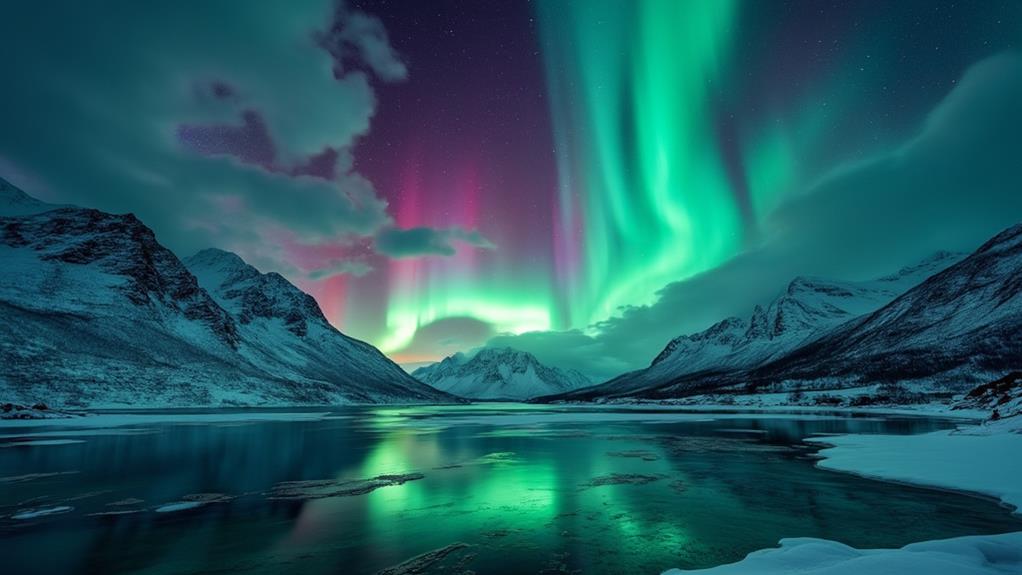
Imagine standing beneath a sky ablaze with the radiant hues of the aurora borealis, punctuated by flashes of green lightning. This rare combination not only captivates photographers but also highlights the significance of natural events. Both the aurora borealis and green lightning are stunning atmospheric phenomena, showcasing the intricate interplay between weather systems and solar activity.
These events ignite scientific curiosity and public interest, emphasizing the importance of understanding our environment. Witnessing such extraordinary occurrences is more than just a visual spectacle; it offers insights into:
- The interaction between weather systems and solar activity
- Space weather and its effects on Earth's atmosphere
- Atmospheric conditions and their dynamics
- Environmental changes and patterns
Documenting these phenomena contributes to scientific research by providing invaluable data on how space weather impacts Earth's atmosphere. This understanding helps decode the complexities of our planet's environmental changes. Moreover, the thrill of experiencing auroras and lightning together fosters a deeper connection with nature, inspiring personal fulfillment and aspirations in nature photography. Embrace the unpredictability and wonder of these natural phenomena, as they continue to reveal the beauty and power of our world.

